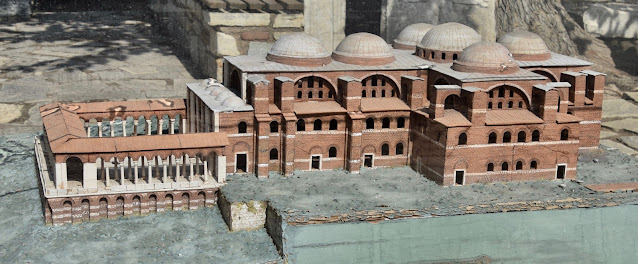
In mid-June, Bishop Akakije went on a pilgrimage to the tomb of the Holy Apostle John the Evangalist and Theologian, the beloved disciple of Christ. The place of his repose (or ascension) and burial is located in Asia Minor, in a place where later the Byzantine village Agios Theologos was founded in his honor. After the Turkish conquest (11th century), the name was changed to Ayasoluk, which in Turkish means “holy breath.” Only in the 20th century, when the Young Turk revolutionaries/nationalists changed all place names which were connected to Christianity, was the village renamed Selçuk after the Seljuk Turks who took Asia Minor from the Romans. From here on in this text we will refer to the village as Ayasoluk. Located right on the Agean coast, it falls within the Izmir Province of Attaturk’s Turkish Republic. It became the main settlement of Ephesus after the ancient city itself was completely destroyed during the Romeo-Arabian wars in the 7th century.
The life of St John the Theologian tells us that after his exile on the island of Patmos, he spent his last days in Ephesus. When it came time for him to repose, he went with his seven disciples and told them to dig a crosss-shaped grave, at a certain place which was later the Hill of St John the Theologian, and there to bury him alive. On the next day, when the rest of the Christians of Ephesus heard of this, they came to his grave, but upon opening it, they did not find his body. Every year after that, on the 8th of May, as a comfort to his disciples, a very fine dust, fragrant and healing, came out of the grave. This dust, through the prayers of St. John the Theologian, healed the sick and brought spiritual comfort to all who received it. This holy dust was called “Manna”. The entire occurrence with the burial of St. John the Theologian indicates that the beloved disciple of the Lord was taken bodily into Heaven, like the Most Pure Theotokos and the prophets Elijah and Enoch.
 |
| Icon of the Dormition of St John the Theologian |
During the first centuries of Christianity a small mausoleum church was built on this spot. Then Emperor Theodosius I built a large basilica over it (246 f x 144 f), over which Emperor Justinian built an even larger basilica (426 x 213) which in magnificence was only comparable with such masterpieces as Agia Sophia and the Church of the Holy Apostles in Constantinople or the basilica of St Appolinarius in Ravenna. It was considered one of the wonders of the world in the middle ages, a fact witnessed to by the famous Roman historian Prokopius of Caesarea. He writes that the Basilica of St John the Theologian was one of the most venerated holy places and that it enjoyed great honor in the Roman Empire. In Roman chronicles the Basilica of St John the Theologian became one of the most visited pilgrimage sites by Christians from the West as well as the East.
 |
One factor which surely contributed to this great veneration was the holy dust, or Manna, which would come out of the tomb of the Holy Evangelist during the All-night Vigils on the night between the 7th and 8th if May (Old Style). Accounts of this miracle have been preserved in the writings of the Gallic pilgrim (and nun?) Egeria (4th century), St. Augustin of Hippo (5th century), and St. Willibald of Bavaria, the enlightener of Germany (8th century), all of whom came to venerate the tomb of St John the Theologian and witnessed the miraculous appearance of dust. St Willibald mentions special little bottles on which were engraved an image of the Saint which were filled with the holy dust. The little bottles of dust were distributed by the clergy to pilgrims who took them to their homes to heal the sick. The dust even calmed sea storms.
In the 16th century the Seljuk conquerors occupied this territory and converted the basilica into a mosque. In 1402 the basilica was torn down to the foundations during Tamerlane’s invasion. During the Greco-Turkish wars (1920-22), while attempting to free Asia Minor, the Greeks undertook an archeological excavation of the basilica and discovered the grave of St. John the Theologian. Under pressure from the West and Unesco and with their finances, the newly-formed Turkish Republic continued the archeological excavation and partially reconstructed the demolished and buried parts of the basilica. Today the basilica of St John the Theologian is a tourist attraction of this area visited by millions of tourists from all over the world. Pilgrims, however, are few, if any.
Above the basilica of St John the Theologian on the Ayasoluk hill rises a Roman fortress of the same name which along with the basilica formed one whole built with great stones, walls and towers. The fortress was built in the fifth century in order to protect the basilica from Arabian conquerors.
The grave of St John the Theologian is under the altar of the church in a crypt with metal bars, to the disappointment of the pilgrims. On the surface part of the altar above the grave is a reconstructed marble square with four marble pillars, one on each corner. Here the altar table once stood. In front of this platform, facing the altar alcove is an authentic marble-lined opening from which according to tradition appeared the miraculous dust from the crypt.
 |
| In front of Bp Akakije one can see the hole leading to the crypt out of which the holy dust emerged. |
In front of the altar platform, Bishop Akakije read an Akathist to the saint, remembering the names of the living and the dead, and afterwards singing the troparion to the saint, accompanied the whole time by our nuns. Icons of St. John the Theologian were placed above the grave of the saint for the prayers, and at the end of the prayers, the pilgrims collected dust from the crypt under the altar. The blessed icons and dust from the grave will be distributed among the monasteries and parishes of the Serbian True Orthodox Church as a blessing. A good amount of dust will be kept at the hermitage of St John the Theologian under the Mikulj rock (For more about the hermitage of St. John the Theologian, click here.)
 |
| In front of the Cave of the Seven Youths in Ephesus |
The third location of the pilgrimage of holy sites in Ephesus which Bishop Akakije visited was the ruins of the great metropolitan cathedral of Our Lady (early 5th century) which is located within the archeological excavation of Ephesus. This church was where the Third Ecumenical Council which condemned the heresy of Nestorius and confirmed the Orthodox teaching of the Virgin Mary as the Mother of God, the Theotokos. This was the first church in the world dedicated to the Theotokos, and where St Mark of Ephesus ruled as Metropolitan. Until the fourth century it was also where the relics of the Holy Apostle Timothy, the first bishop of Ephesus and the closest disciple and co-struggler of the Holy Apostle Paul, to whom headdressed two epistles, were kept. The relics of St Timothy were taken from Ephesus to Constantinople to the Church of the Holy Apostles, from which, during the Crusades in the 13th century, they were taken to Termoli, a city in Italy on the Adriatic coast.

In front of the Church of the Theotokos in Ancient Ephesus
Asia Minor and Ephesus were the apostolic assignment of St. John the Theologian, who lived here with Our Most Pure Lady. Nonetheless, the first preacher of the Gospel in Asia Minor and Ephesus was Apostle Paul who is considered to be the founder of the church of Ephesus (54 AD). St. Paul addressed one epistle to the Christians of Ephesus and two to their bishop, St Timothy. It was in Ephesus that St. John the Theologian wrote his gospel and three epistles. Ephesus is also mentioned as one of the seven churches of the Apocalypse from the vision of St. John the Theologian. The seven churches of the Apocalypse are Ephesus, Smyrna, Pergamum, Thyatira, Sardis, Philadelphia, and Laodicea.
Holy
Apostle St. John the Theologian,
Beloved
of the Lord, Pray to God for Us!



Нема коментара:
Постави коментар